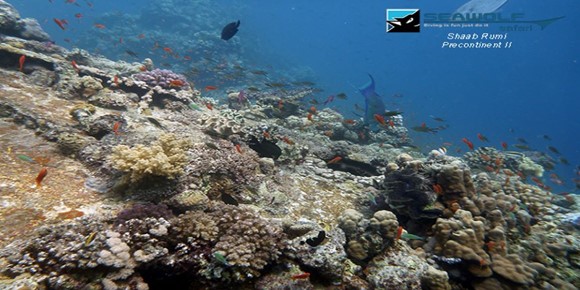Overview
The name of this fringing reef translates as "Reef of the Romans". It is located at the height of Marsa Daror, 9 nautical miles off the mainland coast. 1.2 nautical miles long and 0.5 nautical miles wide, it forms an elongated reef tongue at its southern end.
Description
The east side
With the intermittent current, nice drift dives can be made on this side. The reef wall drops steeply into the deep blue. At the southern end of the east side the diver will find a narrow slope from 20 meters. At 30 and 60 meters respectively, small step-like ledges nestle into the slope. The entire wall is beautifully vegetated and huge gorgonians stretch their fans into the current. Vermillion seabass and butterflyfish stand close to the reef. Schools of copper snapper and spiny mackerel move along the wall. Especially in the morning hours pelagic big fishes come up from the depth. On a dive, in addition to various species of sharks, manta rays can occasionally be encountered. At the south end, in the area of the plateau approach, a small collection of anemones can be admired in the shallows. Due to the attractive south plateau, dives on the east side are rarely made.
The north plateau
The frequent northerly current provides a nice growth of stony and soft corals on the three-stepped plateau. The first ledge is in shallow water at 3 to 4 meters water depth. Numerous surgeonfish and various butterflyfish populate the poorly vegetated reef top. Down to a depth of 12 meters there is a sloping slope, which is populated with colonies of white and blue staghorn corals. At the foot of this slope is the second plateau. It descends steadily to 30 meters and is covered with numerous soft corals. The abundance of fish on the plateau is not as great as on the steep wall, where numerous fish and other reef inhabitants fill the corals with bustling life. Below a slope, at a depth of about 60 meters, begins the third stage, on the northern end of which stands a larger coral pile. In the channel between the pile and the slope sometimes silhouettes of hammerhead sharks can be seen. Especially in the period from late summer to autumn, they often move beyond the limits accessible to the recreational diver. On the east side, in the shallower area, schooling fish such as spiny mackerel, copper snapper and red sea fusiliers swim along the reef.
Hotspots
- Especially in the morning hours pelagic big fishes come from the depth. During a dive, besides various species of sharks, occasionally manta rays can be encountered.

 ENGLISH
ENGLISH
 РУССКИЙ
РУССКИЙ
 DEUTSCH
DEUTSCH

